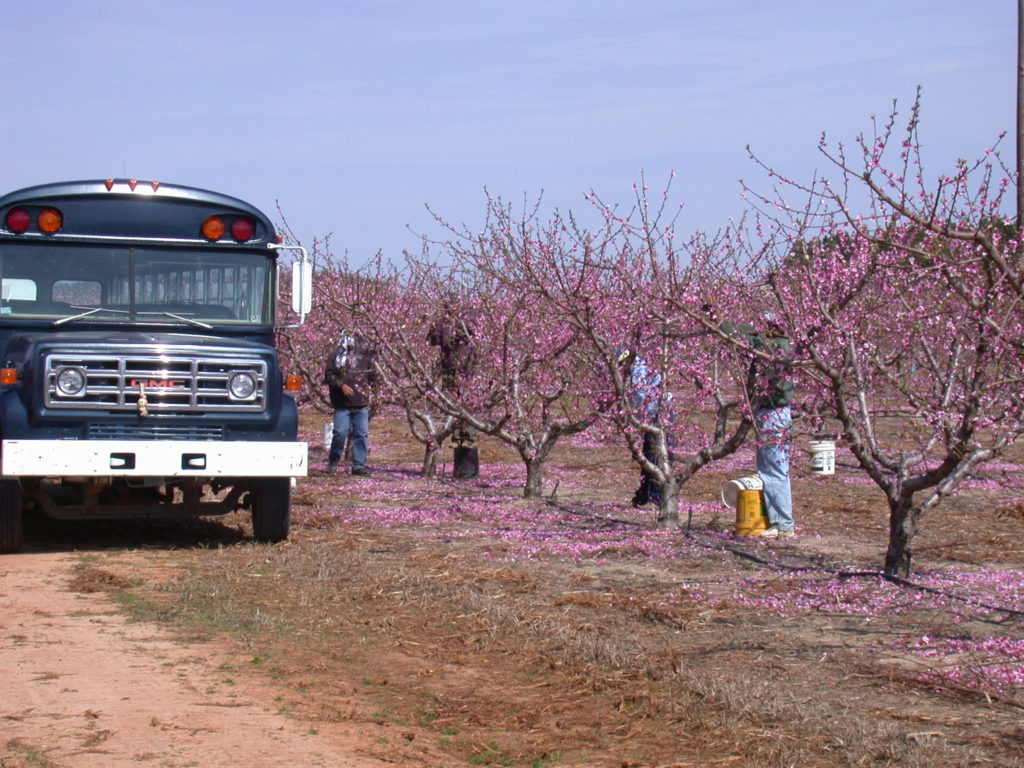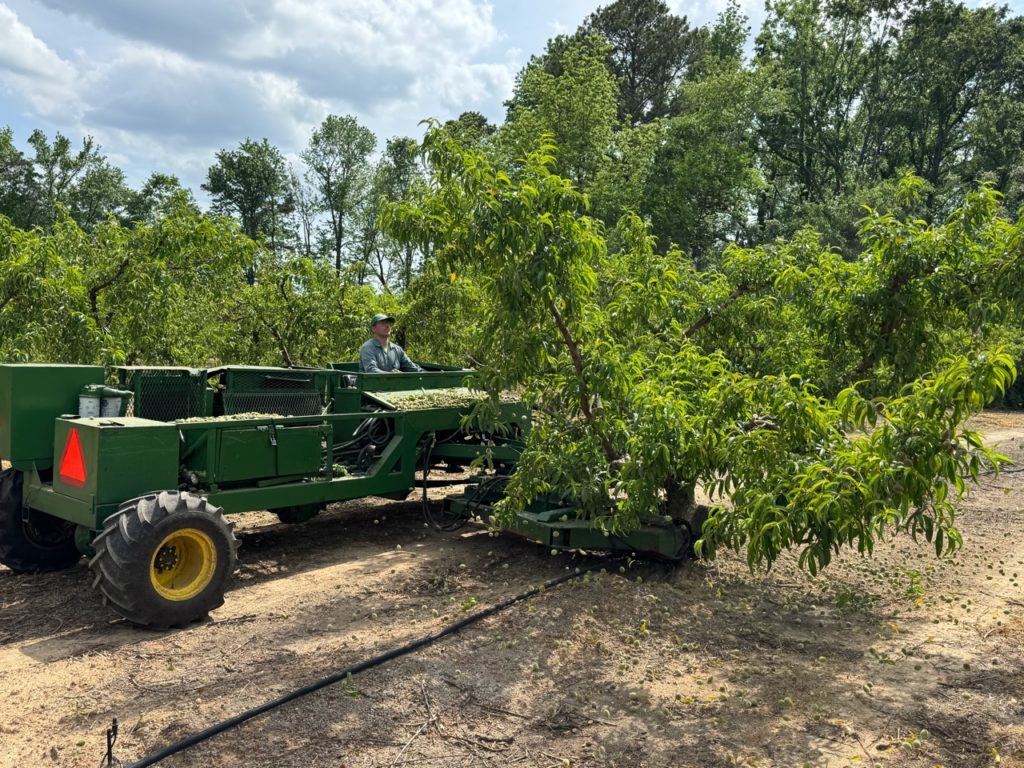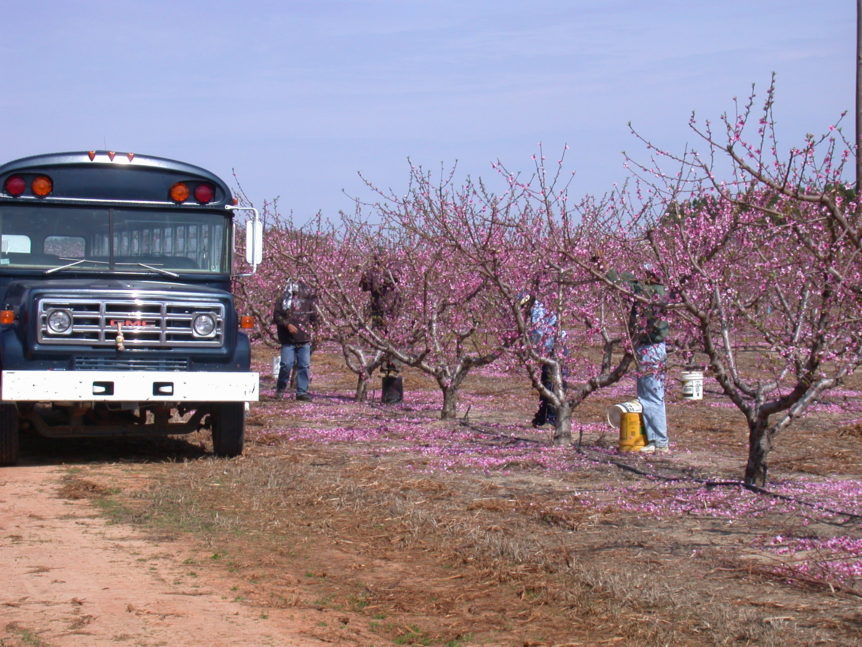
Photos by Greg Reighard
By Frank Giles
There’s a fine line between thinning peaches to produce good marketable-sized fruit and thinning too aggressively which results in reduced yield. Growers and researchers have been working to perfect the practice for many years.
Among those researchers are Juan Carlos Melgar, Clemson associate professor of pomology, and Greg Reighard, Clemson professor emeritus of horticulture. Their research has focused on various chemical and mechanical means to thin peaches in addition to optimizing hand thinning.
“Hand thinning is still the standard practice among growers in South Carolina,” Melgar says. “We are learning how to use a new chemical thinner that is now labeled for peaches, but its effectiveness depends on the varieties it is being applied to and the environmental conditions at the time. So, we are still experimenting and learning how to best use this material.”
Trialing the Thinner

The new product is called Accede from Valent USA. It is a plant growth regulator that is registered for use in key peach-production states. Its active ingredient is 1-aminocyclopropane-1-carboxylic acid (ACC), which is a naturally occurring plant hormone. The labeled rates for the product range from 300 parts per million (ppm) to 600 ppm.
“ACC is a precursor to ethylene in plants,” Melgar says. “When you see leaves fall on plants, that’s ethylene. When we apply Accede, you have ethylene creation in the next two to three days. Then, after that, over the next 10 days or so, it begins to decline to levels before the application was made.”
Melgar has conducted trials with the product in two South Carolina locations — the Ridge and Upstate. The Ridge trial looked at the lower labeled rate of 300 ppm and two applications of 300 ppm versus a control on four cultivars: Summer Prince, Caroking, June Prince and Scarlet Prince. The product was applied at bloom, but the lower rates didn’t appear to have the needed effect on thinning.
The Upstate trial looked at higher rates of 600 ppm, 800 ppm and 1,200 ppm on August Prince and Harvester varieties. The study also looked at different water volumes per acre: 50, 75 and 100 gallons.
“At 300 ppm, we didn’t see any clear effect of the treatments, but we did see a consistent reduction of fruit numbers at 600 ppm,” Melgar says. “In this study, we didn’t collect yield and fruit quality data, but we could do this in the future.”
While more research needs to be done, Melgar believes Accede has the potential to help growers with peach thinning. That work is ongoing.
Machine Considerations
Hand thinning peaches is labor intensive and expensive. All sorts of machines aim to assist in the task and lower costs. Reighard has studied different machines over the years. He has found some that work, but often there’s been limitations that have not fit South Carolina peach production. Some of those limitations include the architecture of trees, operator fatigue and machine durability.
“There are currently growers who have large acreages to thin in South Carolina that are using trunk shakers to take off a significant amount of fruit before hand or bat thinning,” Reighard says. “Full crops like this year cannot be cost effectively thinned with just hand labor.
“The concern with trunk shaking is the larger fruit are removed. But, generally, this is not an issue as the packinghouse does not want 3-inch fruit for most of its sales. Shakers that have been calibrated for tree size and crop load usually do an acceptable, cost effective first thinning.”
A French company has developed a machine with a freely rotating rotor with semirigid rods. Researchers in Spain have used the machine on peach trees that are on vase (3D) systems, and it seems to work well on flower thinning.
“When they used it for thinning fruitlets, it saved labor and improved size but considerably reduced yield, so it doesn’t seem ideal,” Melgar says. “Could our growers thin at a flower stage instead of fruitlet stage? Yes, they can, and in fact some of them do, but bloom thinning is risky if a spring frost occurs; then they may have no crop.
“In a year like this one, when in the end we didn’t have any spring frost, early (bloom) thinning not only saves money but improves fruit size, as more resources can be directed to the flowers/fruitlets that stay on the tree.”
Some would consider a late frost, particularly in March, a blessing because it would kill off a small percentage of fruitlets and help with thinning. This season there was good chill accumulation, good flower production and no frost, so there was a lot to thin.
“Growers do a good job at balancing risks with the potential marketability of their crop. They would love to have a chemical thinner that works and helps them reduce hand thinning,” Melgar says. “They know the benefits of thinning early, and often they would like to thin earlier, but their large operations and the labor costs associated with hand thinning makes it difficult for them to have thinning crews going through all their orchards at the desired time.”










